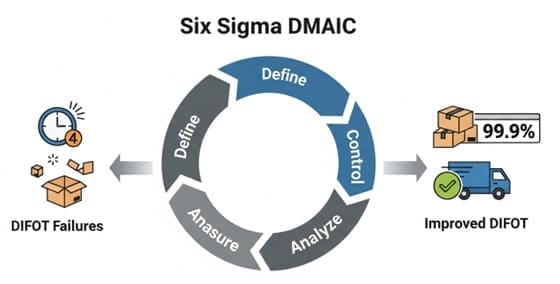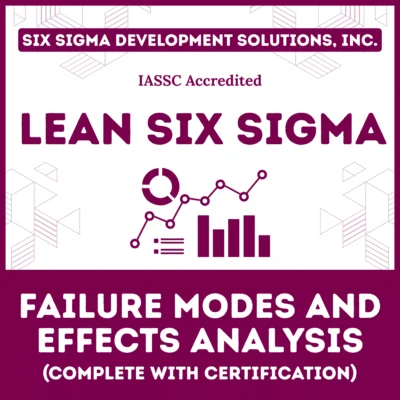In an industry defined by precision engineering and exhilarating performance, the gap between a product’s potential and its arrival in the customer’s hands can determine success or failure. The roar of a supercharged engine and the thrill of incredible speed mean little if the product itself fails to arrive as promised. This is where operational excellence becomes as crucial as engineering innovation.
This guide explores the powerful synergy between Six Sigma, a data-driven methodology for eliminating defects, and Delivery In Full, On Time (DIFOT), the ultimate measure of supply chain effectiveness. Using the pinnacle of motorcycle engineering, the Kawasaki Ninja H2, as a benchmark, we will break down how Six Sigma principles can transform your delivery performance, ensuring that the promise of excellence is consistently fulfilled.
Table of contents
- Criticality of Delivery In Full, On Time (DIFOT)
- Six Sigma: Your Data-Driven Path to Precision Improvement
- The Synergy: How Six Sigma Transforms DIFOT Performance
- Understanding DIFOT: The Foundation of Customer Trust
- Common Operational Bottlenecks and Causes of Low DIFOT
- Six Sigma Explained
- The DMAIC Roadmap for Boosting DIFOT: A Step-by-Step Guide
- Essential Six Sigma Tools for DIFOT Transformation
Criticality of Delivery In Full, On Time (DIFOT)
DIFOT is more than a metric; it’s a promise to your customer. It measures the percentage of orders delivered with the correct items, in the correct quantity, at the agreed-upon time and location. A high DIFOT score is a direct indicator of a healthy, efficient, and customer-centric supply chain.
It builds trust, enhances reputation, and forms the bedrock of customer loyalty. In contrast, a low DIFOT score signals internal chaos, leading to dissatisfied customers, increased operational costs, and lost revenue.
Six Sigma: Your Data-Driven Path to Precision Improvement
Six Sigma is a disciplined, statistical-based methodology that provides businesses with the tools to improve the capability of their business processes.
The core objective is to reduce process variation and eliminate defects, aiming for a standard of just 3.4 defects per million opportunities (DPMO). It’s not about working harder; it’s about working smarter, using data to identify the root causes of problems and implementing sustainable solutions that drive near-perfect operational performance.
Public, Onsite, Virtual, and Online Six Sigma Certification Training!
- We are accredited by the IASSC.
- Live Public Training at 52 Sites.
- Live Virtual Training.
- Onsite Training (at your organization).
- Interactive Online (self-paced) training,
The Synergy: How Six Sigma Transforms DIFOT Performance

The Six Sigma DMAIC cycle provides a structured framework where DIFOT failures are treated as ‘defects’ to be systematically eliminated, leading to improved delivery performance.
The connection between Six Sigma and DIFOT is direct and powerful. DIFOT failures—late shipments, incorrect items, or incomplete orders—are all “defects” in the delivery process.
By applying Six Sigma’s structured approach, particularly the DMAIC (Define, Measure, Analyze, Improve, Control) framework, organizations can systematically dissect their supply chain, pinpoint the sources of these defects, and implement robust changes. This synergy transforms the delivery process from a reactive, unpredictable function into a proactive, reliable, and highly efficient engine for customer satisfaction.
Also Read: How do you align QFD in Six Sigma with your organization’s strategy and goals?
Understanding DIFOT: The Foundation of Customer Trust
Before improving a metric, one must fully grasp its components and significance. DIFOT is the ultimate litmus test for your supply chain’s health, directly reflecting your ability to meet customer commitments.
Defining Delivered In Full, On Time (DIFOT)
DIFOT is a composite key performance indicator (KPI) that has two critical components, both of which must be met for an order to be considered successful:
- In Full (IF): The customer receives every single item they ordered. There are no missing products, incorrect items, or short quantities. If 99 out of 100 units arrive, the “In Full” component has failed.
- On Time (OT): The complete order arrives within the delivery window promised to the customer. Not early, and certainly not late.
An order is only counted as a DIFOT success when both “In Full” and “On Time” criteria are perfectly met. This strict, unforgiving definition is what makes it such a powerful measure of operational capability.
Why High DIFOT is Non-Negotiable for Business Success?
Achieving a high DIFOT rate is essential for modern businesses. It directly impacts customer satisfaction and loyalty, as customers today expect flawless execution. Consistently meeting delivery promises builds a reputation for reliability, a key differentiator in a competitive market.
Financially, high DIFOT reduces costs associated with returns, redeliveries, and customer service interventions. It streamlines inventory management, prevents stockouts, and optimizes logistics, leading to a more efficient and profitable operation from the warehouse to the final destination.
Common Operational Bottlenecks and Causes of Low DIFOT

Low DIFOT is rarely the result of a single issue; it’s typically a symptom of deeper, systemic problems within the supply chain. Common culprits include:
- Inventory Inaccuracy: Discrepancies between system data and physical stock lead to promising products that aren’t actually available.
- Poor Supplier Performance: Late or incomplete deliveries from suppliers create a domino effect down the line.
- Inefficient Warehouse Processes: Slow picking, packing, or dispatching processes can cause delays and errors.
- Communication Gaps: Misalignment between sales, logistics, and warehouse teams results in incorrect order information.
- Transportation Delays: Unforeseen shipping issues, poor route planning, or carrier unreliability can derail on-time delivery.
Six Sigma Explained
Six Sigma is the methodological engine that powers the journey toward operational perfection. It provides the structure, tools, and philosophy needed to systematically dismantle the problems that erode DIFOT performance.
What is Six Sigma?
At its heart, Six Sigma is a business management strategy that seeks to improve the quality of process outputs by identifying and removing the causes of defects and minimizing variability. Originally developed for manufacturing, its principles are now applied across industries.
It uses a set of quality management methods, mainly empirical and statistical, and creates a special infrastructure of people within the organization who are experts in these methods. For a high-performance machine like the Ninja H2, with its powerful inline 4-cylinder engine, Six Sigma ensures that the manufacturing precision translates into delivery precision.
The DMAIC Methodology
The most widely used Six Sigma methodology for improving existing processes is DMAIC, a five-phase framework:
- Define: Clearly articulate the problem (e.g., low DIFOT rate), the project goals, and the customer requirements.
- Measure: Collect data to quantify the current process performance and establish a baseline.
- Analyze: Analyze the collected data to identify the root cause(s) of the defects (DIFOT failures).
- Improve: Develop, test, and implement solutions that address the identified root causes.
- Control: Implement measures to sustain the gains and ensure the process remains stable and in control over the long term.
Also Read: Integrated Risk Management
Core Principles Guiding Six Sigma for Supply Chain Excellence
Three core principles underpin the Six Sigma philosophy and are directly applicable to enhancing DIFOT:
- Customer Focus: The definition of a “defect” is determined by the customer’s expectations. For DIFOT, this means a perfect order every time.
- Data-Driven Decisions: Six Sigma replaces guesswork and assumptions with statistical analysis. Every decision is backed by verifiable data.
- Process Improvement: The focus is not on blaming individuals but on improving the underlying processes that lead to errors.
The DMAIC Roadmap for Boosting DIFOT: A Step-by-Step Guide
Applying the DMAIC framework provides a clear, logical path to systematically improving your DIFOT performance. Each phase builds upon the last, ensuring a thorough and effective improvement project.
Define: Clearly Stating Your DIFOT Improvement Project
In the Define phase, the team creates a project charter. This document outlines the problem: “Our DIFOT rate for aftermarket parts is 78%, leading to customer complaints and increased shipping costs.” It sets a clear goal: “Increase the DIFOT rate to 95% within six months.” The scope is defined (e.g., focusing on a specific product line or warehouse), and the project team is assembled. This stage ensures everyone is aligned on the objective and the definition of success.
Measure: Quantifying Current DIFOT Performance and Baseline
Here, the focus shifts to data. The team must establish a reliable way to measure the current DIFOT rate. This involves collecting data on every order, noting whether it was delivered “in full” and “on time.” This baseline measurement is critical; it’s the starting point against which all future improvements will be compared.
Analyze: Uncovering the Root Causes of DIFOT Failures
With a baseline established, the Analyze phase begins the investigation. The team uses statistical tools and process analysis to drill down into the data and identify the true root causes of failure. Why are orders late? Why are they incomplete? It’s not enough to say “warehouse error.” Six Sigma demands deeper inquiry: Is it a specific picking zone? A particular time of day? A flawed inventory system? This phase separates the trivial many causes from the vital few that are responsible for the majority of problems.
Improve: Developing and Implementing Targeted Solutions
Once the root causes are confirmed, the team brainstorms and develops potential solutions in the Improve phase. For instance, if analysis reveals that inventory inaccuracy for the Trellis frame component is a major cause of “In Full” failures, a solution might be to implement a cycle counting program.
Control: Sustaining Your DIFOT Gains for Long-Term Success
Making an improvement is one thing; sustaining it is another. The Control phase is about making the new process permanent. This involves updating standard operating procedures (SOPs), training employees on the new methods, and implementing monitoring systems.
Essential Six Sigma Tools for DIFOT Transformation
Six Sigma’s power lies in its extensive toolkit, which provides structured methods for analysis and problem-solving at each stage of a DMAIC project.
Process Mapping (SIPOC, Value Stream Mapping)
Process maps are visual tools that help teams understand how a process currently works. A SIPOC (Suppliers, Inputs, Process, Outputs, Customers) diagram provides a high-level overview, while a Value Stream Map (VSM) offers a more detailed look, identifying all the steps, delays, and information flows involved in fulfilling an order. These maps are invaluable for spotting waste, bottlenecks, and non-value-added activities.
Data Collection and Descriptive Statistics (Check Sheets, Histograms, Run Charts, Scatter Plots)
Effective problem-solving requires good data. Simple tools like check sheets help in systematically gathering information about the frequency of specific DIFOT failures. Histograms can then visualize this data to show the distribution of problems. Run charts track performance over time to identify trends or shifts, and scatter plots help determine if a relationship exists between two variables (e.g., order size and picking errors).
Root Cause Analysis Techniques (Fishbone Diagrams, 5 Whys, Fault Tree Analysis)
These techniques are central to the Analyze phase. A Fishbone (or Ishikawa) diagram helps teams brainstorm potential causes of a problem by categorizing them (e.g., Man, Machine, Method, Material, Measurement, Environment). The 5 Whys is a simpler but powerful technique of repeatedly asking “Why?” to drill down from a symptom to its root cause. Fault Tree Analysis is a more formal, top-down deductive method used to analyze complex system failures.
Statistical Process Control (Control Charts)
Control charts are the cornerstone of the Control phase. These are specialized run charts with statistically calculated upper and lower control limits. By plotting process data (like daily DIFOT rates) on a control chart, teams can distinguish between “common cause” variation (the natural noise in a process) and “special cause” variation (an unexpected event that needs investigation). They provide a clear signal when a process is becoming unstable.
Failure Mode and Effects Analysis (FMEA)
FMEA is a proactive risk assessment tool used to identify potential failure points in a process before they occur. The team identifies potential failure modes, their potential effects on the customer, and their potential causes. Each is then scored for severity, occurrence, and detection to calculate a Risk Priority Number (RPN), allowing the team to focus improvement efforts on the highest-risk areas.
Integration with Lean Principles (5S, Poka-Yoke)
Six Sigma is often paired with Lean methodologies. Lean focuses on eliminating waste and increasing process speed. Principles like 5S (Sort, Set in Order, Shine, Standardize, Sustain) create an organized and efficient workplace, reducing the chance of errors. Poka-yoke, or mistake-proofing, involves designing processes so that errors are impossible to make, such as using scanners that won’t allow the wrong item to be picked for an order.
Broader Organizational Benefits of Six Sigma for Delivery Performance
Implementing Six Sigma to boost DIFOT yields benefits that extend far beyond the logistics department, creating a ripple effect of positive change across the entire organization.
Enhanced Customer Satisfaction and Unwavering Loyalty
At the end of the supply chain is a customer. Consistently perfect orders build profound trust and loyalty. When a customer knows their order for a new set of high-performance electronics or a critical component will arrive exactly as promised, they are more likely to become repeat buyers and brand advocates. This reliability is a powerful competitive advantage that can’t be easily replicated.
Significant Cost Reductions Across the Supply Chain
DIFOT failures are expensive. They generate costs from redelivering items, processing returns, expediting replacement shipments, and increased customer service workload. By systematically eliminating the root causes of these failures, Six Sigma directly attacks these sources of waste. This leads to lower operational costs, reduced inventory holding costs (due to better accuracy), and optimized transportation spending, boosting the bottom line.
Improved Operational Efficiency and Productivity
The journey to higher DIFOT forces an organization to scrutinize and streamline its core processes. The data-driven insights from a Six Sigma project uncover hidden inefficiencies and bottlenecks. Resolving these issues not only improves delivery performance but also increases overall productivity. Warehouse staff spend less time correcting errors, and sales teams spend less time handling complaints, freeing up valuable resources to focus on growth and value-adding activities.
The same discipline that allows the Kawasaki Racing Team to shave seconds off a lap in WorldSBK can be applied to shave hours and days off your order-to-delivery cycle.
Final Words
The pursuit of excellence that drives engineers to create machines like the Kawasaki Ninja H2—with its incredible horsepower, advanced technology, and boundary-pushing supercharged engine—should not end when the product leaves the factory. True excellence extends all the way to the customer’s doorstep. Six Sigma provides the framework and tools to apply that same level of precision and data-driven rigor to your delivery processes.
By focusing on the critical metric of DIFOT and employing the structured DMAIC methodology, organizations can move beyond firefighting and begin systematically eliminating the root causes of delivery failures. The benefits are transformative: heightened customer loyalty, significant cost savings, and a culture of continuous improvement.

About Six Sigma Development Solutions, Inc.
Six Sigma Development Solutions, Inc. offers onsite, public, and virtual Lean Six Sigma certification training. We are an Accredited Training Organization by the IASSC (International Association of Six Sigma Certification). We offer Lean Six Sigma Green Belt, Black Belt, and Yellow Belt, as well as LEAN certifications.
Book a Call and Let us know how we can help meet your training needs.




















